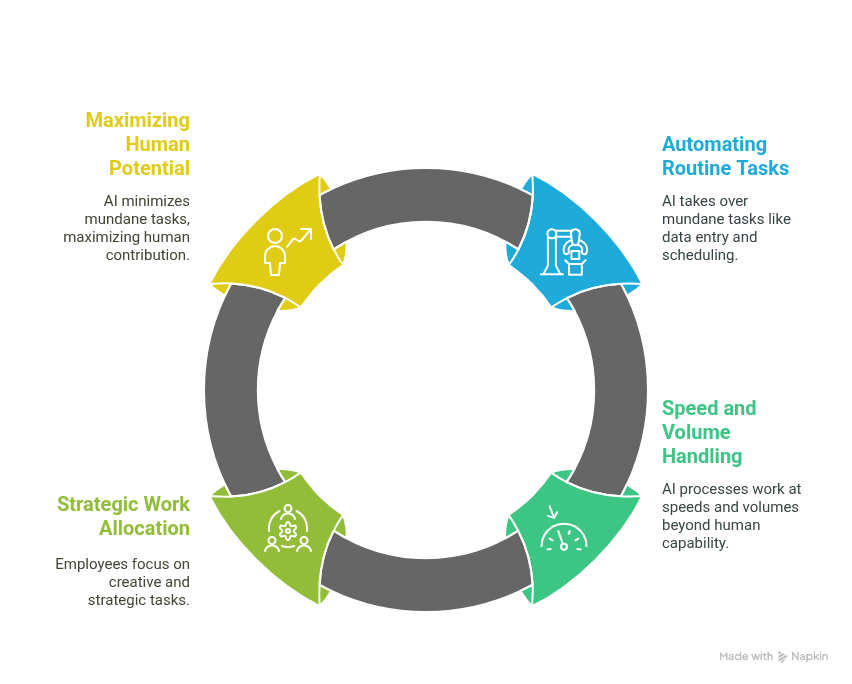How Is AI Helping Businesses: A Comprehensive Guide

Artificial intelligence is transforming businesses by automating routine tasks, enhancing decision-making with data intelligence, driving cost savings, revolutionizing customer experiences, and creating new revenue streams. Companies across industries are leveraging AI to increase efficiency, reduce errors, and gain competitive advantages in an increasingly digital marketplace.
Key Takeaways
- AI automates routine tasks, freeing human talent for strategic work
- Data-driven decisions replace gut feelings with actionable insights
- Businesses achieve significant cost savings through predictive maintenance and optimization
- Customer experiences become more personalized and responsive
- AI enables new revenue streams and business capabilities
- Implementation works best with strategic, incremental approaches
How Artificial Intelligence is Transforming Business Operations Today
Artificial intelligence has moved beyond theoretical applications to become a practical, powerful tool transforming how businesses operate. Rather than a futuristic concept, AI now serves as a fundamental component of modern business strategy, helping organizations work smarter, faster, and more efficiently across all departments and functions.
The impact is tangible: companies implementing AI solutions are experiencing measurable improvements in productivity, decision quality, customer satisfaction, and ultimately, profitability. As AI technologies continue to mature, they're creating unprecedented opportunities for businesses to reimagine their operations and competitive positioning.
In this article, we’ve compiled a diverse selection of reports and expert sources to provide a deeper exploration of the topic. See the table below for a summary.
| Source | Key Insights |
|---|---|
| Advantages and Challenges of AI in Companies | Discusses the benefits of AI, such as enhanced efficiency and decision-making, alongside challenges like implementation complexity and ethical considerations. |
| 5 Key Benefits of Integrating AI into Your Business | Highlights advantages including improved efficiency, data-driven decision-making, enhanced customer experiences, reduced human error, and innovation opportunities. |
| The Road to Better Processes: Integrating AI Along the Way | Explores how AI integration streamlines business processes, leading to cost savings and improved operational efficiency. |
| 12 Key Benefits of AI for Business | Outlines benefits such as better decision-making, increased efficiency, enhanced customer service, and the ability to process large data volumes. |
| A Comprehensive Guide on AI Integration in Business Processes | Provides a step-by-step approach to integrating AI, emphasizing the importance of aligning AI initiatives with business goals. |
| How to Make AI Work for Your Business: A Quick 7-Step Guideline | Offers a concise guide for businesses to effectively implement AI, focusing on identifying key areas for integration and setting clear objectives. |
| ProcessGPT: Transforming Business Process Management with Generative Artificial Intelligence | Introduces ProcessGPT, demonstrating how generative AI can revolutionize business process management by automating and improving workflows. |
| From Words to Workflows: Automating Business Processes | Discusses methods for automating business processes using AI, emphasizing the transition from natural language inputs to executable workflows. |
This compilation provides a comprehensive overview of the benefits, challenges, and methodologies associated with AI integration in business contexts.
Also, the image below provides a clear overview of the key benefits.

Boosting Efficiency and Productivity

One of the most immediate and transformative benefits of artificial intelligence in business lies in its ability to significantly enhance efficiency and productivity. By taking over routine and repetitive tasks, AI liberates human workers from activities that consume time but require little in the way of creativity or judgment. This shift allows organizations to redirect valuable human talent toward more strategic and rewarding work.
AI systems excel at automating mundane responsibilities such as data entry, appointment scheduling, and handling basic customer inquiries.
👉 Research indicates that such tasks can account for up to 60–70% of an employee’s workload. Automating these processes not only boosts overall productivity but also opens up substantial opportunities to reassign human resources to areas where their skills can be more impactful.
In addition to automating existing workflows, AI can perform tasks at speeds and scales that are simply beyond human capability. In software development, for example, AI tools can generate large volumes of test data almost instantly. This capacity allows developers to spend more time on creative coding and problem-solving, rather than being bogged down by repetitive testing procedures.
As AI handles more of the routine workload, employees are freed to focus on roles that demand strategic thinking, emotional intelligence, and innovation. This reallocation of effort not only improves the quality of work but also enhances job satisfaction and engagement, as individuals are empowered to contribute in more meaningful and fulfilling ways.
Ultimately, the integration of AI into daily operations creates a powerful synergy between technology and human potential. By minimizing the time spent on low-value activities, businesses can maximize the unique strengths of their workforce, fueling innovation, improving performance, and driving sustained growth.
Enhancing Decision-Making with Data Intelligence

Artificial intelligence is fundamentally changing the way businesses make decisions, shifting the emphasis from intuition and experience to data-driven strategies. While traditional decision-making often relies on human judgment—which can be valuable—it is also susceptible to cognitive biases and limitations. AI offers a powerful complement by providing objective analysis based on vast and diverse datasets, resulting in more balanced and effective decision outcomes.
One of AI’s most important strengths is its ability to analyze large and complex datasets to uncover patterns and correlations that would be virtually impossible for humans to detect. These hidden insights can inform a wide range of business areas, from strategic planning and product development to operational efficiency and market positioning. By bringing such patterns to the surface, AI enables leaders to make choices grounded in evidence rather than assumptions.
However, AI’s true value goes beyond data processing. What sets it apart is its ability to transform massive volumes of information into clear, actionable insights.
👉 According to a Deloitte report, 59% of executives believe that AI enhances their ability to extract actionable intelligence from data, helping them make better decisions faster and with greater confidence. This acceleration of decision-making not only improves responsiveness but also gives organizations a competitive edge.
Real-world examples illustrate the power of AI in action. Shell, for instance, uses AI to analyze highly complex geological data to determine the most promising locations for drilling, optimizing resource allocation and reducing risk. In the healthcare sector, IBM Watson assists professionals by analyzing medical literature and patient records to recommend evidence-based treatments, particularly in oncology. These use cases demonstrate how AI can process information at scale and deliver insights that fundamentally elevate the quality and precision of decisions.
Driving Significant Cost Savings

Beyond boosting productivity, artificial intelligence offers significant cost savings across various areas of business operations. Its ability to automate, predict, and optimize makes AI a powerful tool for reducing expenses while maintaining or even improving performance and reliability.
One of the most direct ways AI contributes to cost reduction is through automation. By taking over routine, repetitive processes—such as administrative tasks, data processing, or simple customer service interactions—AI helps businesses cut down on labor costs. At the same time, it frees up employees to concentrate on higher-value work that drives innovation, revenue growth, and competitive differentiation.
In equipment-heavy industries, AI adds another layer of savings through predictive maintenance. By analyzing sensor data and detecting patterns in equipment usage, AI can forecast when machines are likely to fail or require servicing. This allows companies to perform maintenance just in time—avoiding unexpected breakdowns and reducing expensive downtime. As a result, equipment runs more efficiently and lasts longer, enhancing the return on investment in physical assets.
AI is also transforming how businesses manage energy consumption. Smart systems powered by AI can monitor and automatically adjust heating, cooling, and lighting in real time based on occupancy and environmental conditions. These optimizations help reduce utility bills and support broader sustainability goals by minimizing unnecessary energy usage.
Altogether, these AI-driven efficiencies—automation, predictive maintenance, and intelligent energy management—work together to extend asset lifespans, minimize downtime, and reduce operational costs.
👉 In the long run, businesses that adopt AI not only save money but also position themselves to operate more sustainably and competitively in an increasingly resource-conscious world.
Revolutionizing Customer Experience

Artificial intelligence is fundamentally transforming how businesses engage with their customers, making interactions more personalized, responsive, and satisfying. By leveraging data and intelligent systems, companies can now understand individual preferences and behaviors at an unprecedented level, allowing for more meaningful and effective customer experiences.
At the core of this transformation is AI’s ability to analyze massive volumes of customer data. From purchase history and browsing habits to support interactions and stated preferences, AI systems can synthesize this information into detailed customer profiles. These insights empower businesses to tailor communications, promotions, and product offerings in a way that feels genuinely personalized—enhancing relevance and deepening customer loyalty.
AI also powers the recommendation engines that have become standard in industries like retail and entertainment. Platforms such as Netflix and Amazon use advanced algorithms to suggest content and products based on user behavior and preferences. These personalized recommendations significantly boost user engagement and drive sales by delivering exactly what the customer is most likely to want—often before they even ask for it.
Customer service has also seen a revolution thanks to AI-driven chatbots. Unlike their rigid predecessors, today’s chatbots can understand natural language, interpret intent, and offer personalized support in real time. Available 24/7, these systems reduce wait times and support costs while improving satisfaction by providing fast, accurate, and human-like assistance at scale.
The impact of AI-driven personalization reaches far beyond e-commerce. In healthcare, AI helps craft individualized treatment plans. In beauty and fashion, tools like Sephora’s Virtual Artist allow users to try on products virtually. In financial services, AI can offer customized advice and product recommendations based on a customer’s spending habits and financial goals. These tailored experiences illustrate how AI is redefining customer engagement across industries—turning data into a powerful engine for connection, satisfaction, and growth.
Creating New Business Capabilities and Revenue Streams

Beyond enhancing existing operations, artificial intelligence opens the door for organizations to develop entirely new capabilities and unlock fresh sources of revenue. Rather than simply optimizing what already exists, AI empowers businesses to think differently—identifying new opportunities, reimagining services, and moving faster than ever before.
One of AI’s most powerful contributions is its ability to uncover untapped market opportunities. By analyzing large volumes of market data, consumer behavior trends, and competitive dynamics, AI can highlight underserved segments or emerging customer needs that businesses might otherwise overlook. These insights allow companies to proactively enter new markets or create targeted offerings that address specific gaps.
Organizations are also finding innovative ways to transform existing data into brand-new service lines. For instance, autonomous vehicle companies are using the driving data they collect to design customized insurance products. Similarly, insurance providers are leveraging their risk analytics to offer fleet management solutions to commercial clients. These new offerings turn previously unused data into valuable products—unlocking entirely new revenue streams.
AI doesn’t just help with what to build—it speeds up how fast you can build it. By streamlining research, modeling, testing, and iteration, AI compresses product development cycles, enabling companies to respond more quickly to evolving customer needs and market conditions. This agility is essential in today’s fast-paced business environment.
👉 As Seth Early from Early Information Science puts it, AI can “speed up the clock of a company,” enhancing the pace of decision-making and implementation. This increased speed-to-market gives businesses a crucial competitive edge—allowing them to act decisively, launch faster, and stay ahead in markets where timing can make all the difference.
Improving Quality and Reducing Human Error

AI systems bring a level of consistency and quality to business operations that is difficult to achieve through manual processes. By minimizing human error and variability, AI helps organizations deliver reliable, high-standard outcomes across a wide range of functions—ensuring both efficiency and trust.
In many operational areas, consistency is critical. Unlike human workers, who can be affected by fatigue, distraction, or gaps in training, AI systems operate with unwavering precision. This makes them especially valuable in quality-sensitive environments such as manufacturing, where even minor inconsistencies can lead to significant losses, and in customer service, where uniformity in interactions enhances brand trust and customer satisfaction.
Financial processes are another area where AI’s accuracy provides significant value. Tasks such as reconciliation, transaction processing, and regulatory compliance require meticulous attention to detail. AI systems can handle thousands of these transactions with near-perfect precision, drastically reducing the risk of errors that could lead to financial losses or regulatory issues. 👉 The result is not only cost savings but also stronger governance and risk management.
When AI is combined with Robotic Process Automation (RPA), its impact becomes even greater. While RPA excels at rule-based tasks, integrating AI introduces cognitive abilities such as natural language understanding and decision-making. This combination allows businesses to automate more complex workflows that once required human intervention—creating end-to-end solutions that are both smart and scalable.
Perhaps most importantly, AI systems don’t just maintain performance—they improve over time. Thanks to machine learning, these systems learn from new data, feedback, and outcomes, becoming increasingly accurate and efficient. This self-improving nature means the longer AI is in use, the more value it delivers, helping organizations evolve continuously without major reinvestments in retraining or restructuring.
Practical Steps for AI Integration
Organizations can take a structured approach to AI integration to maximize success and minimize risks.

Identifying high-impact use cases
The most successful AI implementations begin with identifying specific business problems or opportunities where AI can deliver substantial value. Focus on areas with clear ROI potential and alignment with strategic objectives.
Starting with small pilot projects
Rather than attempting enterprise-wide transformation immediately, successful organizations typically begin with controlled pilot projects. These limited implementations allow testing and refinement before broader deployment.
Training employees and collaborating with experts
Effective AI implementation requires both technical expertise and organizational adoption. Invest in training employees to work effectively with AI systems while partnering with specialists who bring deep technical knowledge.
Continuously monitoring and refining AI solutions
AI implementation isn't a one-time project but an ongoing process of refinement. Establish mechanisms to monitor performance, gather user feedback, and continuously improve your AI solutions.
Success Stories: Companies Leading with AI
Many leading organizations demonstrate the transformative potential of strategic AI implementation.
Amazon's recommendation engine and supply chain management
Amazon's recommendation engine drives approximately 35% of its sales, while its AI-powered supply chain management ensures product availability while minimizing inventory costs. These capabilities have been central to Amazon's market dominance.
Google's search algorithms and cloud services
Google's core search functionality relies on sophisticated AI to deliver relevant results, while its cloud services offer AI capabilities to other businesses. The company's early and sustained investment in AI has secured its market leadership.
BMW's manufacturing automation
BMW has integrated AI throughout its manufacturing processes, from quality control to production planning. These implementations have improved efficiency, reduced defects, and enhanced customization capabilities.
Netflix's content recommendation and production decisions
Netflix uses AI not only to recommend content to viewers but also to inform production decisions about new shows and movies. This data-driven approach has helped the company create highly successful original content while optimizing its content acquisition strategy.
Artificial intelligence has moved from a theoretical concept to an essential business tool, transforming operations across industries. By automating routine tasks, enhancing decision-making, driving cost savings, revolutionizing customer experiences, and enabling new business models, AI is helping companies work smarter, faster, and more profitably in an increasingly competitive global marketplace.
